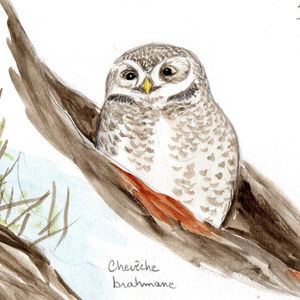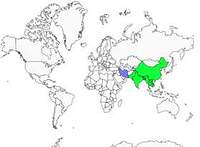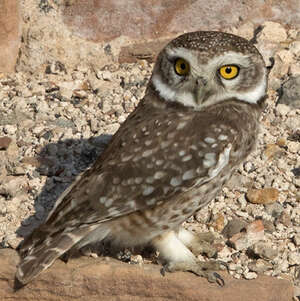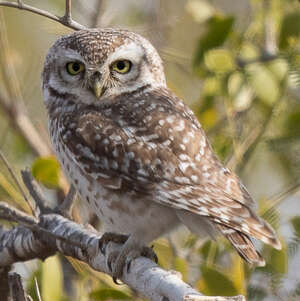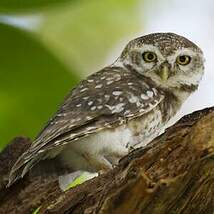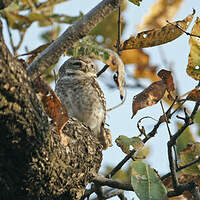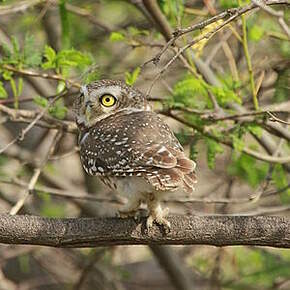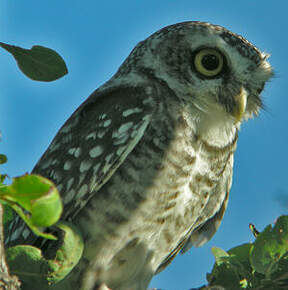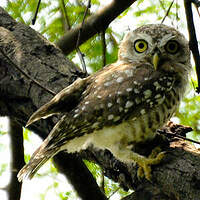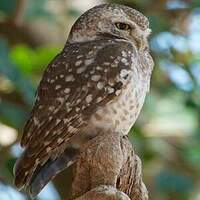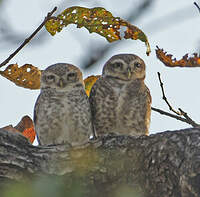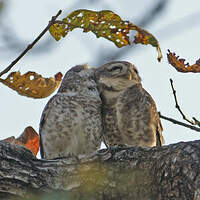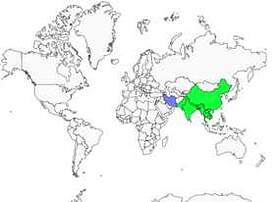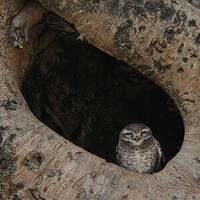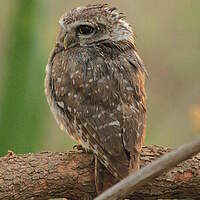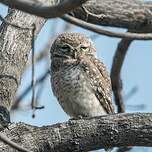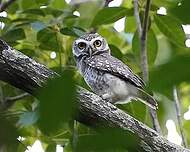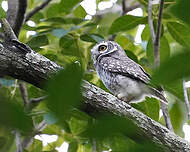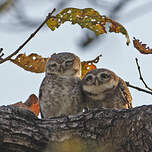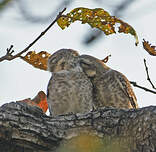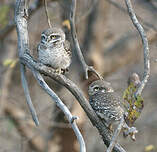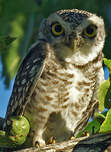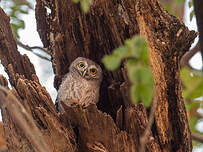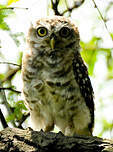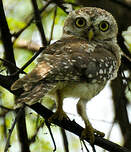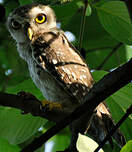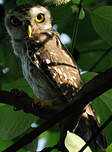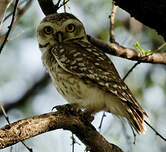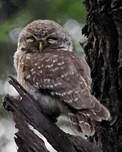Spotted Owlet
Athene brama - Chevêche brame
Identification
The Spotted Owlet has been known since the beginning of the 19th century in the region of Pondicherry and the south of the Indian peninsula. The Spotted Owlet, an Asian version of the Eurasian Scops Owl, is smaller than its European cousin. It is a small nocturnal raptor, dappled in white, with plumage ranging from dark gray-brown to brown; its head is rounded, the occipital disc is barely marked, the eyes' circumference is indistinctly marked. The irises are yellow. The tail is relatively short with fine white bars.
The lower parts are cream colored or chamois white with many dark scaly bars on the sides, breast, and sides. Its toes are feathered and the eyes are yellow.
The Spotted Owlets look very much like Scops Owls, although their body is stockier and their lower colors more solidly colored. The tails' bars are broader. The tail and tarsi are more strongly barred. The Eurasian Scops Owl is more restricted in size. The belly and mantle stripes are more longitudinal in shape.
The juveniles have bright white down. The mesoptile approaches the adults' plumage very closely. There is usually less white on the hood and mantle. The belly stripes are less longitudinally marked. The eyes are very pale yellow, the wax and beak are greenish. The feet are mottled green, and the claws of the talons are horn.
Subspecific information 5 subspecies
- Athene brama brama (s India)
- Athene brama indica (Iran to n and c India, Bhutan and Bangladesh)
- Athene brama ultra (Assam. ne India.)
- Athene brama pulchra (c, s Myanmar, s China)
- Athene brama mayri (n, e Myanmar, Thailand, s Laos, Cambodia and s Vietnam)
Foreign names
- Chevêche brame,
- Mochuelo brahmán,
- mocho-malhado,
- Brahmakauz,
- brama kuvik,
- Brahmaanse Steenuil,
- Civetta macchiata,
- brahminuggla,
- Tempelugle,
- kuvik škvrnitý,
- sýček brahmínský,
- Indisk Kirkeugle,
- brahmanpöllö,
- mussol Braman,
- pójdźka bramińska,
- punktainais apogs,
- Браминский сыч,
- インドコキンメフクロウ,
- 横斑腹小鸮,
- นกเค้าจุด,
- 橫斑腹小鴞,
Voice song and call
The song is reminiscent of a series of plaintive murmurs mixed with double-whistles. Both vocal partners sing in unison. In the double-whistle pliou pliou, the male's is higher pitched, with the first note being longer and the second note not exceeding one second. Every double-whistle is then repeated after a very long, regular pause of about twenty seconds.
Spotted Owlets are relatively noisy during the breeding season. Harsh and discordant bellowing can be heard which is transcribed as chirrur chirrur chirrur, followed by cheevak cheevak cheevak. These are used for communication during the egg-laying period.
Habitat
Spotted Owlets frequent open and semi-open regions. They can also be seen in semi-deserts, including arid surfaces such as inside and around villages.
Spotted Owlets inhabit the wooded areas which are at sea level up to 1,600 meters above sea level.
Owls that bear the name of Owls are usually classified in the genus Athene, except for the owls in the Indian Ocean center which are enclosed under the name mascarenotus (Réunion, Rodrigues). They also live on the European continent (Noctua) and on the American continent (Cunicularia). The Spotted Owlet is native to the Indian subcontinent (Pakistan, India in its entirety, Bangladesh, Myanmar, Cambodia, Laos and Vietnam up to the Mekong River mouth).
Behaviour character trait
Spotted Owlets maintain themselves in pairs or small familial groups of three to four individuals. They have a crepuscular or nocturnal job, and maintain quite a sustained activity until the full light of mid-day. Even when it is day time, they often continue to hunt.
The nocturnal activity of this bird is explained more by its intolerance to daytime light than by the aggressiveness of small bands, an explanation that is generally advanced in other kinds of owls.
However, in days of full light, the Spotted Owlets regularly retire to the shade, sheltered in shady cavities or on heavily leafed branches, with the two partners close against each other.
Nesting couples betray their presence by the noises they make in the dense branches or by the clamor they produce in the leaves to drive away intruders. The noises caused by head agitations and wing beats complete and finish producing the concert of dissuasion.
At the end of the less lit period, the Spotted Owlets leave their usual shelters which are fence posts, electric wires or sighting places which they use to spot prey and capture their insects. They also make aerial expeditions and use city lighting lamps as their base camp. They pursue insects attracted by these lamps or attract parrots with nuts.Like that of small birds, their flight is composed of rapid flaps.
Flight
Dietfeeding habits
Reproduction nesting
In the north, the breeding season runs from February to August. In the south, southern races breed from November to March.
The nest is a natural cavity built in a tree trunk. The hole can also be dug in a dilapidated or damaged wall, or between pillars or the support of a roof, or in the walls of an abandoned dwelling. The nests are sometimes lined with tufts of grass, with stems or with feathers. The laying includes 2, 4 or 5 eggs, white in color and rounded in shape. The size measures 32 mm by 27. The young participate in some of the tasks. The female always stays close to the laying and incubates alone for a period of 28 to 32 days. The chicks hatch synchronously and are fed by both parents. In the absence of found clues, we assume that there is no nest relocation, droppings, eggshells, pellet regurgitation or remains of prey. At the age of 32 days, the small owls leave the nest but they do not move away and they continue to be cared for and educated for an additional 3 weeks. They reach sexual maturity before the start of the next season.Geographic range
A. b. indica (Franklin, 1831) - South of Iran, South of Pakistan (also South of Afghanistan) eastward to Bhutan and Bangladesh passing through the center and the north of the Indian subcontinent.
A. b. ultra - Northeast India (Arunachal Pradesh and East of Assam).
A. b. brama (Temminck, 1821) - South of the Indian subcontinent.
A. b. pulchra - Centre and South of Myanmar.
A. b. mayr - Northeast of Myanmar, Thailand (except the extreme south) South of Laos, Cambodia and South of Vietnam.
Spotted Owlet - South of Iran, South of Pakistan (also South of Afghanistan) eastward to Bhutan and Bangladesh passing through the center and the north of the Indian subcontinent, Northeast India (Arunachal Pradesh and East of Assam), South of the Indian subcontinent, Centre and South of Myanmar, Northeast of Myanmar, Thailand (except the extreme south) South of Laos, Cambodia and South of Vietnam.
Threats - protection
IUCN conservation status
concern
in the Wild
threatened
evaluated
According to the Handbook of Birds of the World, this species is not globally threatened. According to Claus Konig, it is even quite common. In some regions, even those planted in figs of the Banians, tamarinds and mango trees, the population density is quite high and can contain a bit more than one couple per tree.
Spotted Owlets typically live near dwellings, crops and abandoned villages. For quite some time, they have been considered declining due to the degradation of their habitat and the decreasing number of sites. The success of broods ranges from 50 to 65%.
Sources of information
- IOC World Bird List (v14.2), Gill, F and D Donsker (Eds). 2024-04-18.
- Vol. 5 - Handbook of the Birds of the World, Josep del Hoyo-Andrew Elliott-Jordi sargatal
- A Field Guide to the Birds of the Indian Subcontinent, Krys Kazmierczak, Ber Van Perlo
- A Photographic GUIDE TO THE BIRDS OF INDIA, Bikran Grewal, Bill Harvey, Otto Pfister
- BirdLife International, BirdLife International
- Planet of Birds,
- The Owl Pages, Deane P.Lewis
- Wikipédia, Wikipedia, The Free Encyclopedia
- Handbook of the Birds of India and Pakistan - vol4, Salim Ali and Dillon Ripley
- Owls of the world, Claus KÖNIG
Other sources of interest
 Specification sheet created on
30/07/2023 by Anne et Gabriel Leboff
Specification sheet created on
30/07/2023 by Anne et Gabriel LeboffTranslation by AI Oiseaux.net
© 1996-2025 Oiseaux.net
- Accipitriformes
- Aegotheliformes
- Anseriformes
- Apodiformes
- Apterygiformes
- Bucerotiformes
- Caprimulgiformes
- Cariamiformes
- Casuariiformes
- Charadriiformes
- Ciconiiformes
- Coliiformes
- Columbiformes
- Coraciiformes
- Cuculiformes
- Eurypygiformes
- Falconiformes
- Galliformes
- Gaviiformes
- Gruiformes
- Leptosomiformes
- Mesitornithiformes
- Musophagiformes
- Nyctibiiformes
- Opisthocomiformes
- Otidiformes
- Passeriformes
- Pelecaniformes
- Phaethontiformes
- Phoenicopteriformes
- Piciformes
- Podargiformes
- Podicipediformes
- Procellariiformes
- Psittaciformes
- Pterocliformes
- Rheiformes
- Sphenisciformes
- Steatornithiformes
- Strigiformes
- Struthioniformes
- Suliformes
- Tinamiformes
- Trogoniformes

